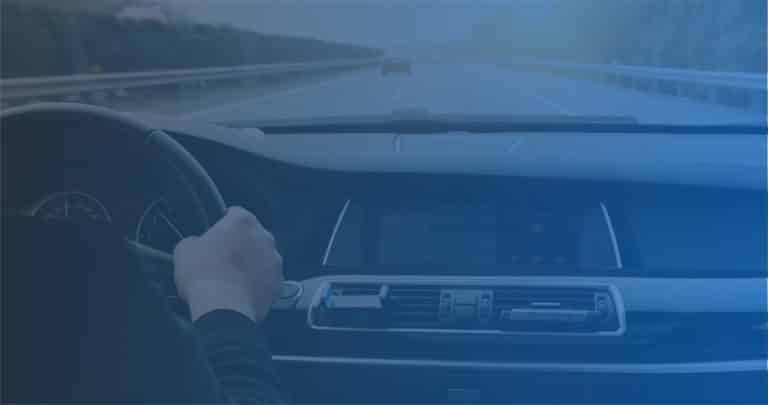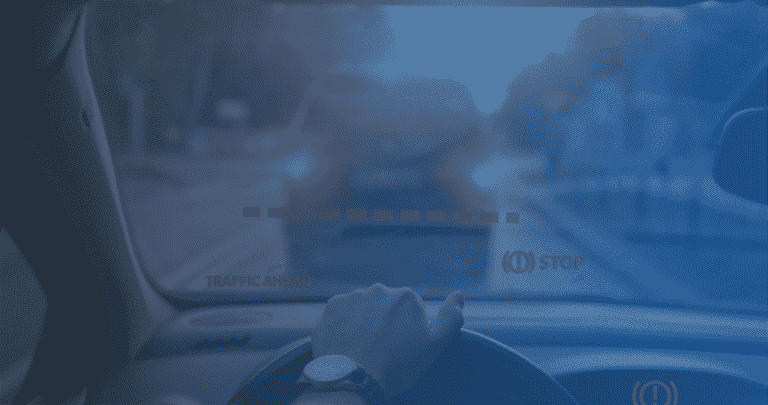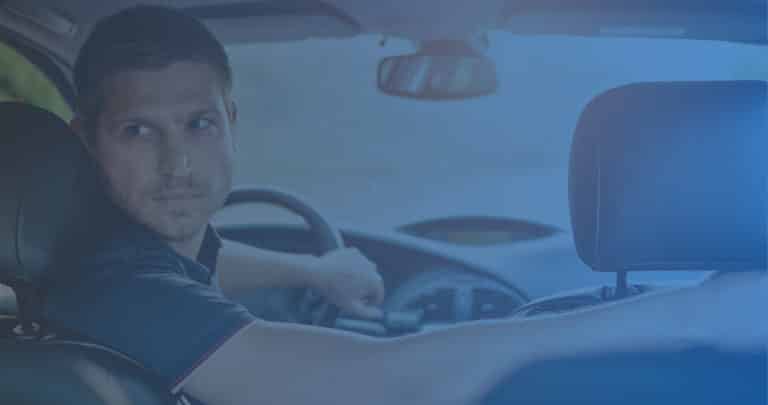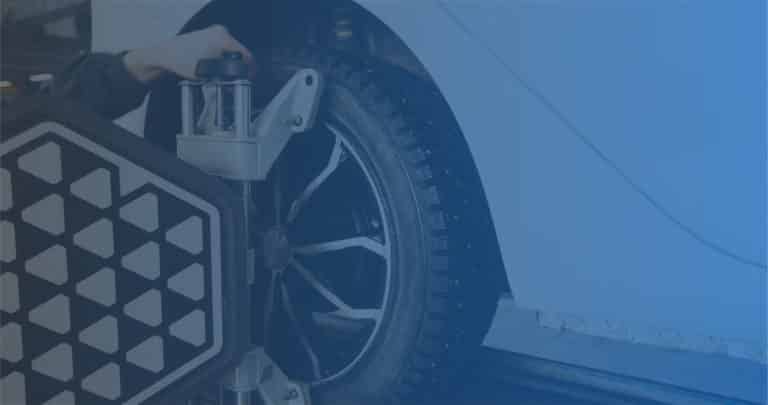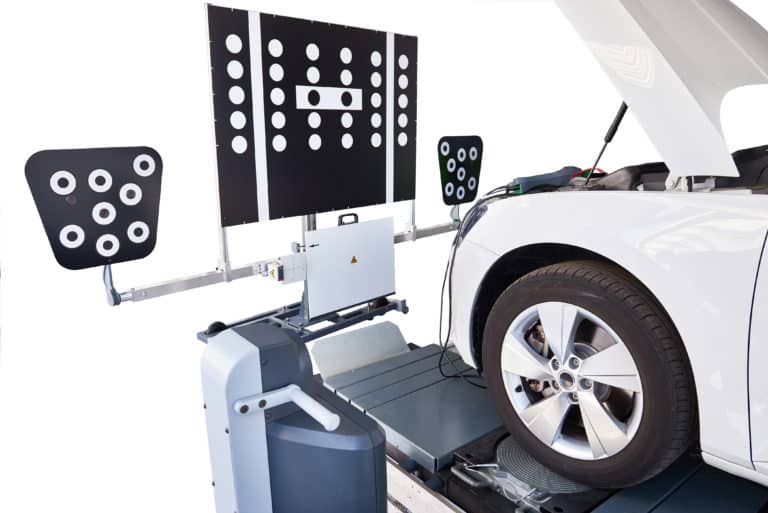It happens all the time. You check your mirrors, look over your shoulder, and shift into reverse. Your car slowly starts reversing, backing out of its parking spot. Suddenly, a car appears, driving down the aisle, almost crashing into you. It’s no wonder that twenty percent of car accidents happen in parking lots. So, how can we reduce the occurrence of fender benders caused by cross traffic you physically can’t see? One way is with driver assistance technology. Rear Cross Traffic Alert is a vehicle safety technology offered on many new car options. This technology can reduce parking lot backing crashes by watching the cross traffic for you.
In this article, we will answer the question “What is RCTA?”, explain how it works, provide examples of RCTA from four OEMs, and save the best for last — RCTA sensor calibration.
What is RCTA?
Rear Cross Traffic Alert (RCTA) is an advanced driver assistance system (ADAS) aimed at making backing up safer when there is a possibility of unseen cross traffic. When your car is in reverse gear, RCTA monitors for vehicles approaching from the sides as you back out of a parking spot.
But what do drivers think of RCTA?
Eighty-five percent of drivers were very satisfied with their RCTA ADAS system in a Consumer Reports survey. What’s even more interesting, 52 percent of respondents said that their RCTA system had helped to avoid a crash. It’s clear that RCTA systems have great potential.
How does Rear Cross Traffic Alert work?
Rear Cross Traffic Alert uses corner radar sensors, located on the left and right sides of a vehicle’s rear bumper, to emit radar waves. When vehicles are approaching (usually between about 3 and 20 miles per hour), drivers are warned by a beep noise, visual cues like an indicator light, or a seat rumble. This warning is triggered when a vehicle enters your car’s radar detection area which extends out from each radar sensor in the vehicle’s rear corners and down the length of the aisle, in both directions, to detect cross traffic.
While radar is the most common tech used in RCTA systems, some OEM versions of this safety feature utilize ultrasonic sensors, also known as rear parking sensors. In general, your car will utilize the same ADAS sensors for blind spot monitoring as it uses to operate RCTA.
Alternative Terms for RCTA
There are various terms used to refer to a vehicle’s RCTA system. Here are a few examples of different names OEMs use to refer to RCTA:
- Rear cross path detection
- Rear cross traffic collision warning/avoidance
- Rear cross traffic assistant
RCTA vs. Parking Sensors
While many cars have parking sensors that work with backup camera systems to help drivers safely park, RCTA is a separate system. It’s also less common. Parking sensors use sonar technology, which only helps to identify obstructions that are very close to the car’s rear bumper. For the most part, parking sensors only pick up stationary objects, while RCTA systems look for moving vehicles, headed toward you.
The difference is in the direction and scope of what a RCTA/BSM corner radar sensor can pick up. These radar sensors have a much larger detection field that extends to the sides of your vehicle. Because the sensors are located on the corners of the vehicle, they can pick up cross traffic, while it’s far enough away to apply the brakes and avoid a collision.
RCTA Works Together with Backup Cameras and Rear AEB
When combined with reverse automatic emergency braking (reverse AEB), Rear Cross Traffic Alert is more than a crash deterrent — it’s a collision-avoidance system. Add in a backup camera and this advanced safety system can make things easier for drivers. When bundled, the ensemble works like this: when you shift into reverse, your backup camera shows the field of view, while radar sensors watch out for cross traffic and if threatening cross traffic isn’t stopping, rear AEB brakes to avoid a collision.
4 Examples of RCTA ADAS Available Now
Several OEMs offer RCTA. But, they are all a little bit different — different in how they activate, and the alerts and actions they provide. To get a better idea of how OEMs’ RCTA versions vary in presentation, here are a few examples.
Chevy Rear Cross Traffic Alert
Chevy offers Rear Cross Traffic Alert as part of its Driver Confidence package. Here’s how Chevy describes its RCTA system:
“Rear cross traffic alert warns you if a vehicle is approaching from the left or right when you are backing up. The feature uses hidden radar sensors in the rear corners of the vehicle. When you are in reverse, these sensors look for approaching left or right cross traffic behind you. When rear cross traffic is detected, a red flashing triangle is shown on the rear vision camera screen which points toward the approaching vehicle. In addition, rear beeps are sounded in the direction of the approaching traffic. If equipped, rather than using directional beeps, the safety alert seat pulses on the left or right side. This feature can be turned on and off using the parking assist system control or in some vehicles, through the vehicle menu setting. Rear cross traffic alert may be particularly helpful in parking situations if your vision is blocked by large vehicles or other side obstructions.”
Toyota Rear Cross Traffic Alert
What is RCTA on Toyota?
Toyota offers Blind Spot Monitor and Rear Cross-Traffic Alert on all models, while it is standard on many models. Here’s how Toyota RCTA is described:
“Backing safely out of a parking spot requires reversing slowly to avoid a collision, especially since vehicles parked adjacent to yours may prevent you from seeing traffic. When the vehicle is shifted into Reverse, the Rear Cross-Traffic Alert (RCTA) system is designed to automatically activate and begin using the BSM’s radar sensors to detect rear cross traffic approaching from either side of the vehicle. If a vehicle is spotted, the system will notify the driver with an audio alert, as well as with a flashing indicator on the side mirrors. The vehicle’s backup camera system or multimedia display will also show an indicator to signal the direction of the approaching vehicle. RCTA functionality is available when backing up at speeds up to 5 mph, and when an approaching vehicle is traveling at speeds between approximately 5 to 18 mph.”
Mazda Rear Cross Traffic Alert
Mazda offers Rear Cross Traffic Alert on some models. Here’s how the automaker describes this feature on the 2021 Mazda CX-5:
“The RCTA system detects vehicles approaching from the rear left and right sides of the vehicle, and the rear of the vehicle while the vehicle is being reversed out of a parking space, and notifies the driver of possible danger using the Blind Spot Monitoring (BSM) warning indicator lights and the warning buzzer.”
Subaru Rear Cross Traffic Alert
Subaru offers a Rear Vehicle Detection package that includes a Rear-Vision Camera, standard on all models. Beyond that, the package includes Blind-Spot Detection with Lane Change Assist, and Rear Cross-Traffic Alert, available on many ’21 and ’22 models. Here’s how Subaru’s RCTA presents:
“Rear Cross-Traffic Alert uses radar sensors to help warn you of traffic approaching from the side as you are backing up, utilizing an audible warning and flashing visual indicators in your side mirrors and Rear-Vision Camera display”
Rear Cross Traffic Alert Sensor Calibration
RCTA is powered through sensors in the rear bumper. If a collision or fender bender happens, your sensors will either need to be recalibrated or replaced and calibrated.
Vehicles are calibrated in auto collision and repair shops or at standalone ADAS calibration centers. The question for those in the collision industry is whether your business can handle the incoming flux of vehicles equipped with RCTA and other ADAS-equipped vehicles, as this year, 92 percent of new cars came with at least one ADAS, standard.
ADAS Calibration Solutions
Car ADAS Solutions is the expert when it comes to ADAS calibrations. We wrote the book on the calibration center framework. If you want to own your own calibration center, contact us about ADAS calibration solutions today!
Read More About RCTA:


